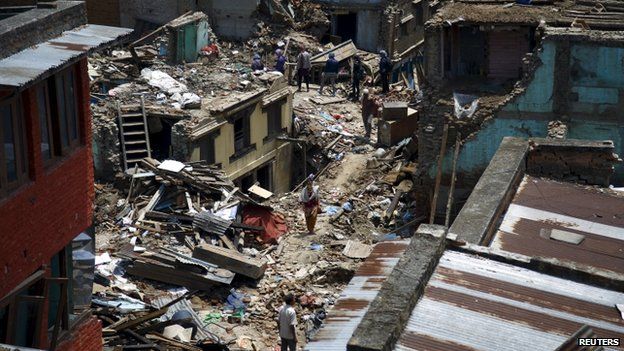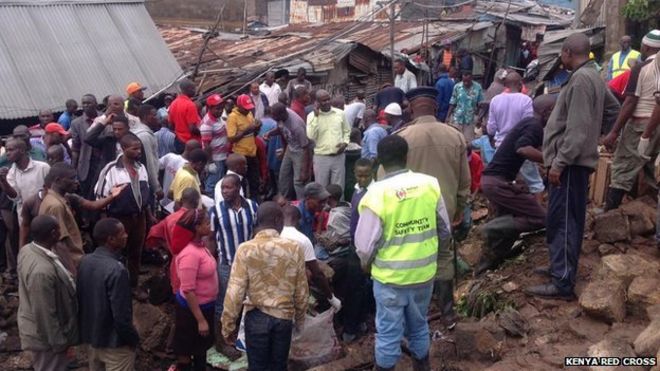
A major earthquake has struck eastern Nepal, near Mount Everest, two weeks after more than 8,000 people died in a devastating quake.
At least 48 people have been killed and more than 1,000 injured, officials say. At least 17 have also died in India.
The latest earthquake hit near the town of Namche Bazaar and sent thousands of panicked residents on to the streets of Nepal's capital, Kathmandu.
It had a magnitude of 7.3, compared with the 7.8 of the 25 April quake.
The latest quake struck at 12:35 Nepali time (06:50 GMT) and was centred about 76km (47 miles) east of Kathmandu, in a rural area close to the Chinese border.
The quake was felt in northern India, Tibet and Bangladesh. India's home ministry said 16 people had been killed in the state of Bihar, and one more in Uttar Pradesh. Officials in China said one person was confirmed dead in Tibet.
Rescue helicopters have been sent to districts east of Kathmandu that are believed to be worst hit. Police in Charikot, 80km north-east of the capital, said 20 people had died there.
Later on Tuesday, the US military said a Marine Corps helicopter involved in disaster relief efforts had gone missing while working in the vicinity of Charikot. Eight people were on board.
A spokesman for Nepal's government told the BBC that 31 of the country's 75 districts had been affected by the latest quake.
Prime Minister Sushil Koirala called for "courage and patience" and urged all those who had assisted Nepal since the 25 April quake "to once again extend your helping hand".
The BBC's Yogita Limaye, who was in Nepal's mountains when the latest earthquake struck, said: "The earth shook and it shook for a pretty long time.
"I can completely understand the sense of panic. We have been seeing tremors - it's been two-and-a-half weeks since the first quake. But this one really felt like it went on for a really long time. People have been terrified."
At least four people were killed in the town of Chautara, east of Kathmandu, where a number of buildings are reported to have collapsed.
The International Organisation for Migration said bodies were being pulled from rubble there.
Krishna Gyawali, the chief district officer for Chautara, said there had been a number of landslides.
Landslides were also reported by Save the Children in Sindhupalchok and Dolakha. A spokeswoman told the BBC its staff had been "dodging huge rocks rolling off the hillside".
Home Minister Bam Dev Gautam said: "Many houses have collapsed in Dolakha... there is a chance that the number of dead from the district will go up."
The BBC's Navin Singh Khadka says the new earthquake has brought down more houses and lodges in the Everest region but that local officials report very few tourists are still in the area following the 25 April quake.
A nurse in Namche Bazaar, Rhita Doma Sherpa, told Reuters: "The school building is cracked and bits of it, I can see, they have collapsed. It was lunchtime. All the kids were outside."
The latest quake struck at a depth of 15km (9.3 miles), according to the US Geological Survey - the same depth as the April quake. Shallow tremors are more likely to cause greater damage at the surface.
Tuesday's earthquake is likely to be one of the largest to hit Nepal, which has suffered hundreds of aftershocks since 25 April.
The 7.3 quake was followed by six aftershocks of magnitude 5.0 or higher.
One tremor that hit 30 minutes later, centred on the district of Ramechhap, east of Kathmandu, had a magnitude of 6.3.
Scientists are already producing some preliminary analyses of Tuesday's quake.
The epicentre this time is about 80km (50 miles) east-north-east of Kathmandu, halfway to Everest. On 25 April, the big quake began 80km to the north-west of the capital.
In April, we saw the fault boundary rupture eastwards for 150km (93 miles). And the immediate assessment suggests Tuesday's tremor has occurred right at the eastern edge of this failure.
In that context, this second earthquake was almost certainly triggered by the stress changes caused by the first one. Indeed, the US Geological Survey had a forecast for an aftershock in this general area.
Its modelling suggested there was 1-in-200 chance of a M7-7.8 event occurring this week. So, not highly probable, but certainly possible.
Quake experts often talk about "seismic gaps", which refer to segments of faults that are, to some extent, overdue a quake. Tuesday's big tremor may well have filled a hole between what we saw on 25 April and some historic events - such as those in 1934, that occurred further still to the east.
Wednesday 13 May 2015
http://www.bbc.co.uk/news/world-asia-32701385



